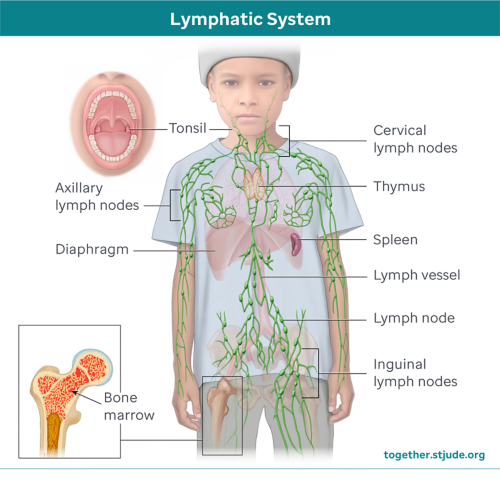What is the immune system?
The immune system is a network of organs, tissues, and cells that work together to protect the body from germs and other invaders. It defends against infection and helps the body heal from illness and injury.
Infections start when germs or pathogens enter the body and multiply to cause illness or damage. These germs or pathogens include bacteria, parasites, viruses, and fungi.
In most cases, the body can defend itself against harmful germs. But certain medical conditions and treatments can weaken your child’s immune system. If your child has a weak immune system, they can get infections more easily and infections can be more serious, even life-threatening.
Sometimes the immune response can be too strong or last too long. The immune system can attack healthy cells. This can result in problems like an allergic response or autoimmune condition.
Parts of the immune system
Skin: The skin is the first line of defense in the immune system. It is a physical barrier that prevents germs from entering the body.
Mucous membranes: The linings of the respiratory and digestive tracts (mucous membranes) also help stop the entry of harmful germs.
White blood cells: Cells of the immune system, including different types of white blood cells, attack and destroy germs.
Lymphatic system: The lymphatic system is a specialized network of lymphatic vessels and organs that help filter germs and waste from the body. Organs and tissues of the lymphatic system include:
- Bone marrow: the soft, spongy material in the center of most bones that makes blood-forming stem cells
- Tonsils: tissues in the back of the throat that filter out germs
- Thymus: organ that makes T-cells, white blood cells that help fight infection
- Spleen: organ that filters germs and damaged red blood cells
- Lymph nodes: small structures that filter lymphatic fluid and have immune cells that fight germs
There are 2 main types of immunity: innate and acquired.
Innate immunity
Innate immunity is the general protection that you are born with, like the skin and certain types of immune cells. Immune cells travel through blood and lymphatic vessels. Some immune cells work to attack any invading germ. When they detect a germ invader, they engulf and destroy the germ.
Adaptive immunity
Adaptive immunity is the protection that your body gets over time as you are exposed to germs. This type of immunity is also called acquired or specific immunity. In acquired immunity, immune cells are trained to recognize and remember specific germs.
One way they do this is through antibodies. Antibodies are specialized proteins that recognize and attach to foreign substances, like bacteria and viruses, so that they can be destroyed. Antibodies often stay in the body for months or years, ready to protect against the same germ in the future. This is how vaccines work to protect against certain diseases.
Infection risk in children with weak immune systems
If your child has cancer, sickle cell disease, or other health condition, your child might be at higher risk of infection.
Increased infection risk may be due to one or more reasons:
- Treatments or diseases can cause breakdown or sores in the skin or membranes lining the mouth and digestive tract.
- The spleen might not work as well to filter germs and fight infection.
- Medical procedures and devices such as central lines and urinary catheters provide a way for germs to enter the body.
- Illness or its treatment may cause low numbers of white blood cells or “low counts.”
Infections can be very serious in patients with a weak immune system. If your child has a weak immune system, their body may not respond quickly to infection because there are fewer immune cells to fight off germs. This can allow infection to spread more quickly or last longer.
If your child has a weak immune system, symptoms of infection can be harder to recognize. In some patients, the only symptom of infection may be a fever.
Neutropenia and Infection Risk
An illness or treatment can reduce the number of white blood cells that are available to fight infection. Neutrophils are a type of white blood cell that kill bacteria and fungi. A low number puts a person at risk for infection. When counts are low, there are not enough immune cells to fight off germs. Germs can start copying themselves and sprpead infection in the body.
Learn more about Absolute Neutrophil Count (ANC) and Neutropenia.
Simple steps can help prevent infection: wash hands often, limit exposure to germs, and get the vaccines recommended by your doctor. Talk to your care team about your child’s risk of infection and know when to seek medical care.




